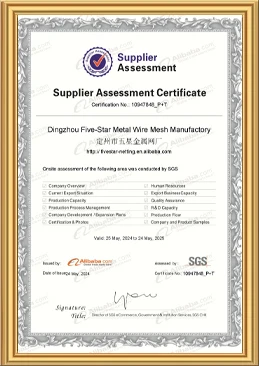Flexible Soft Annealed Wire for Various Applications in Industrial and Craft Projects
Understanding Soft Annealed Wire Properties and Applications
Soft annealed wire is a type of wire that has undergone a specific heat treatment process known as annealing, which enhances its mechanical properties, making it suitable for various applications. This process involves heating the wire to a certain temperature and then allowing it to cool slowly. As a result, the wire exhibits increased ductility, reduced hardness, and improved overall workability, making it a preferred choice in numerous industries.
The primary characteristic of soft annealed wire is its enhanced flexibility. By reducing the internal stresses within the metal, the annealing process allows the wire to be easily bent, twisted, or shaped without risking breakage. This is particularly beneficial in industries such as automotive, construction, and manufacturing, where wire is often required to be formed into specific shapes or configurations for different applications.
In addition to increased flexibility, soft annealed wire also boasts excellent electrical conductivity. Many types of soft annealed wire are made from copper, which is known for its superior conductive properties. This makes soft annealed copper wire ideal for electrical applications, such as in the production of cables, connectors, and other components that require efficient current flow. The smooth surface finish of soft annealed wire further enhances its conductivity since it minimizes resistive losses during operation.
soft annealed wire

Furthermore, soft annealed wire is often coated with various materials to improve its corrosion resistance and durability. For instance, galvanization—coating the wire with a layer of zinc—protects it from oxidizing agents in the environment. This property is crucial for applications that involve exposure to moisture or harsh weather conditions, ensuring that the wire maintains its integrity over time.
One of the most significant applications of soft annealed wire is in the manufacturing of springs. Soft annealed wire's elasticity allows it to return to its original shape after being deformed, making it an ideal choice for various spring designs found in everyday objects, automotive components, and industrial machinery. The ability to customize the hardness through the annealing process further expands the versatility of soft annealed wire in spring production.
Moreover, in the realm of art and craft, soft annealed wire is favored by artisans and jewelry makers. Its pliability allows for intricate designs to be created easily, enabling artists to twist, braid, and wrap the wire to form stunning pieces of art or wearable items. The available diameters of soft annealed wire mean that artisans can choose the thickness that best suits their project, enhancing their creative process.
In conclusion, soft annealed wire is a vital material in various sectors due to its unique properties. With its enhanced flexibility, excellent electrical conductivity, and adaptability to different coatings and applications, it plays a crucial role in everything from industrial manufacturing to fine arts. As technology and industries continue to evolve, the importance of this versatile wire will undoubtedly expand, highlighting the ongoing need for high-quality raw materials in a diverse range of applications. Understanding the characteristics and advantages of soft annealed wire can help in making informed decisions when selecting materials for specific needs.
-
Wire Mesh Solutions for Modern Industrial Needs
NewsJul.17,2025
-
Steel Wire Powers Modern Industrial Applications
NewsJul.17,2025
-
Iron Nails Big Iron Nail Price Guide Bulk Buyers
NewsJul.17,2025
-
Durable T Post Solutions for Industrial Fencing Projects
NewsJul.17,2025
-
Durable Hexagonal Wire Netting For Modern Applications
NewsJul.17,2025
-
Building Material Wholesale Solutions for Modern Construction Needs
NewsJul.17,2025














